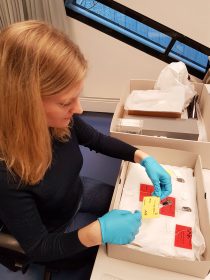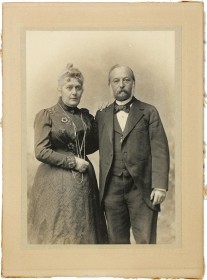Ghetto Life and Beautiful Shoes

Wei Zhang looking at shoes “made in China”, which are part of the Jewish Museum Berlin’s collection; permanent loan by Marion Schubert, née Salomon; Jewish Museum Berlin, photo: Christoph Kreutzmüller
As a student studying the Holocaust at the University of Haifa, I was honored to do a short-term internship at the Jewish Museum Berlin with the team working on the new permanent exhibition. Before it began, I came across a small passage in the book Jewish Responses to Persecution: 1938–1940 (ed. by Jürgen Matthäus, Alexandra Garbarini, Plymouth: AltaMira Press, 2010) written in late 1938, directly after the November pogroms, that illustrated the desperation of German Jews (especially those in Berlin):
“There is one Jewish café open in Berlin. Anyone who wants to see what likely suicides look like should enter this café. The conversation of people sitting there revolves round two topics: how to obtain a passage to Shanghai or how to commit suicide.”
A question came to my mind: Could I find something related to Shanghai, the city where about 20,000 Ashkenazi Jews found refuge, here? As I started my research in the museum’s collection, I was excited to find an abundance of such information. Now I would like to share these stories with you. → continue reading
Object Lessons on our Museum’s History

Trainee Lisa Renner performing inventory; Jewish Museum Berlin, photo: David Studniberg
I still remember my first day of work at the museum well, some months ago. Together with two new colleagues, I rode the elevator one floor down, we passed through two secured doors, and there we were: in the warehouse. There on two iron shelves towered bulging boxes and cartons as well as all kinds of objects — and with them, my job for the next eight months as an academic volunteer at the Jewish Museum Berlin: to set up a little special exhibition on the history of the museum itself.
Somewhat at a loss, I rummaged through a hodgepodge of exhibition papers, invitations, and photographs of people I didn’t know, and asked myself what a wire-frame goose on skateboard wheels or an old elevator sign were doing in a museum. → continue reading

Emanuel and Johanna Stern, ca. 1903; Jewish Museum Berlin, gift of Alexander Summerville
Just over two years ago, I penned a blog text describing a Passover Haggada that I had purchased online. It caught my attention due to the lists of names written on the inside front and back covers of individuals who attended the Passover Seders over the course of seven years that were held in two residences in Berlin, both of which were in close proximity to the Jewish Museum Berlin. Research revealed a substantial amount of information about various persons named therein and my text concluded with the hope that contact might be established with descendants of some of those found in the lists.
At the end of March of this year, I flew to Stockholm to visit Alexander Summerville, the great grandson of Paul Aron, in whose home in the Hedemannstraße 13/14 Passover Seders took place in five of the years for which lists exist in the Haggada. → continue reading


